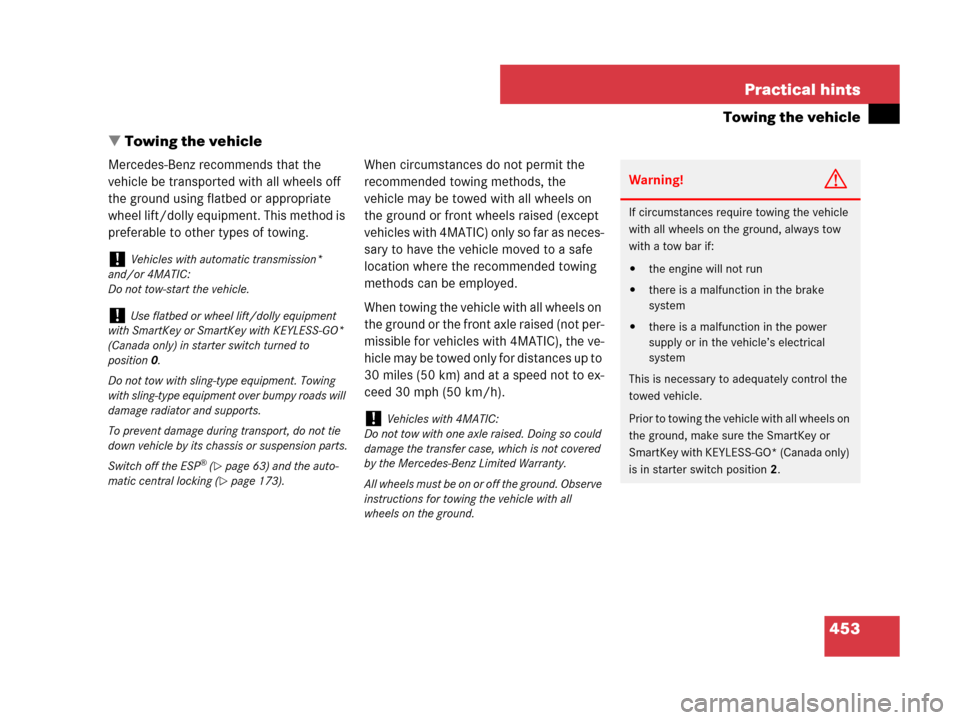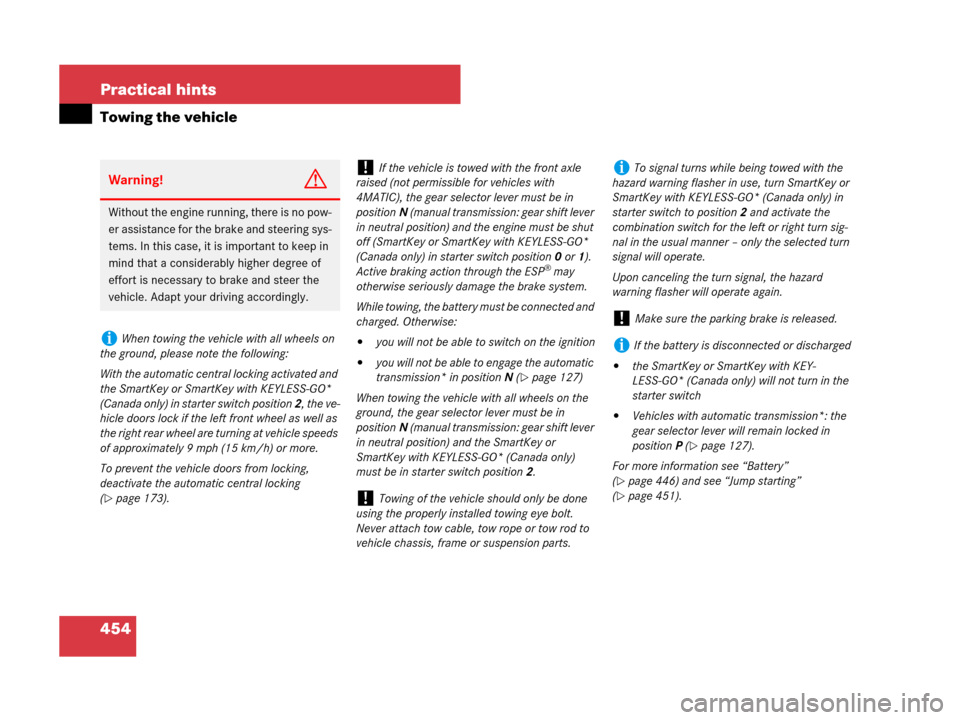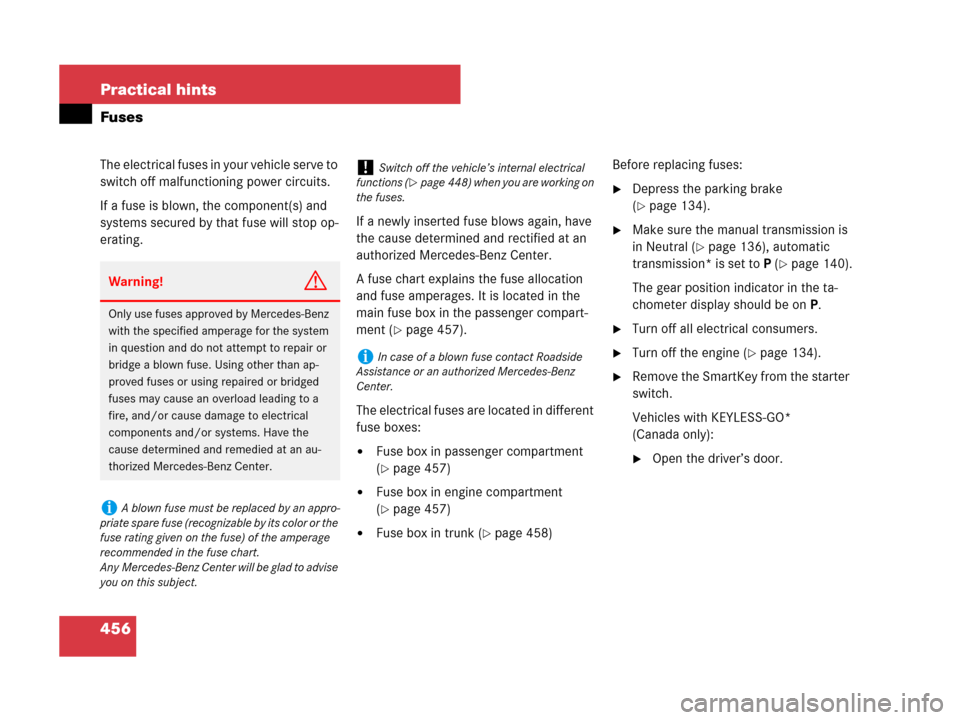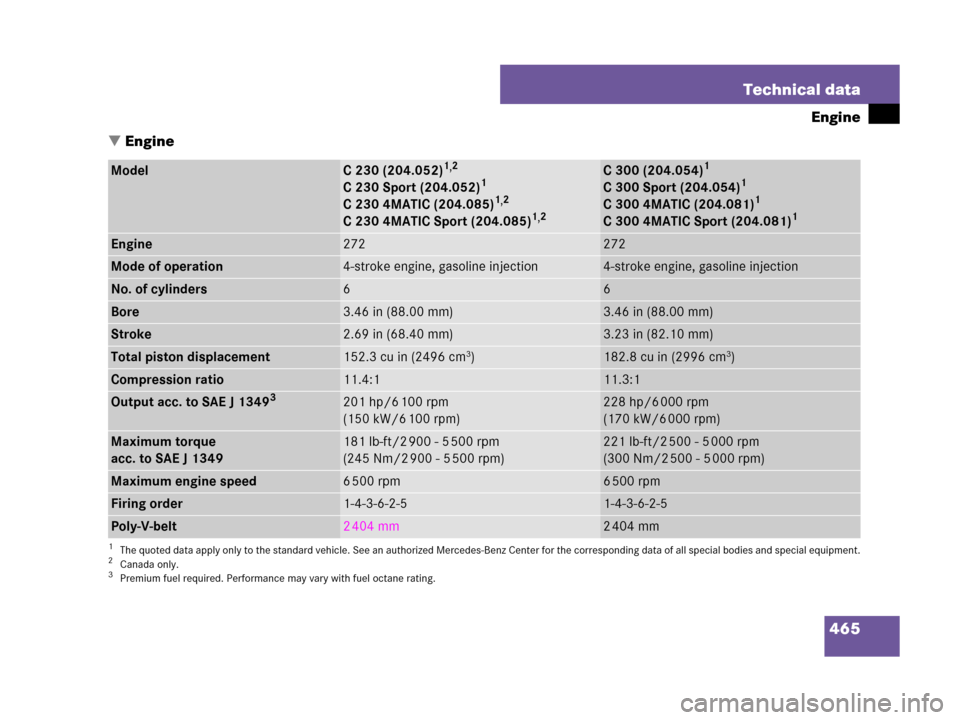Page 454 of 509

453 Practical hints
Towing the vehicle
�Towing the vehicle
Mercedes-Benz recommends that the
vehicle be transported with all wheels off
the ground using flatbed or appropriate
wheel lift/dolly equipment. This method is
preferable to other types of towing.When circumstances do not permit the
recommended towing methods, the
vehicle may be towed with all wheels on
the ground or front wheels raised (except
vehicles with 4MATIC) only so far as neces-
sary to have the vehicle moved to a safe
location where the recommended towing
methods can be employed.
When towing the vehicle with all wheels on
the ground or the front axle raised (not per-
missible for vehicles with 4MATIC), the ve-
hicle may be towed only for distances up to
30 miles (50 km) and at a speed not to ex-
ceed 30 mph (50 km/h).
!Vehicles with automatic transmission*
and/or 4MATIC:
Do not tow-start the vehicle.
!Use flatbed or wheel lift/dolly equipment
with SmartKey or SmartKey with KEYLESS-GO*
(Canada only) in starter switch turned to
position0.
Do not tow with sling-type equipment. Towing
with sling-type equipment over bumpy roads will
damage radiator and supports.
To prevent damage during transport, do not tie
down vehicle by its chassis or suspension parts.
Switch off the ESP
® (�page 63) and the auto-
matic central locking (
�page 173).
!Vehicles with 4MATIC:
Do not tow with one axle raised. Doing so could
damage the transfer case, which is not covered
by the Mercedes-Benz Limited Warranty.
All wheels must be on or off the ground. Observe
instructions for towing the vehicle with all
wheels on the ground.
Warning!G
If circumstances require towing the vehicle
with all wheels on the ground, always tow
with a tow bar if:
�the engine will not run
�there is a malfunction in the brake
system
�there is a malfunction in the power
supply or in the vehicle’s electrical
system
This is necessary to adequately control the
towed vehicle.
Prior to towing the vehicle with all wheels on
the ground, make sure the SmartKey or
SmartKey with KEYLESS-GO* (Canada only)
is in starter switch position2.
Page 455 of 509

454 Practical hints
Towing the vehicle
Warning!G
Without the engine running, there is no pow-
er assistance for the brake and steering sys-
tems. In this case, it is important to keep in
mind that a considerably higher degree of
effort is necessary to brake and steer the
vehicle. Adapt your driving accordingly.
iWhen towing the vehicle with all wheels on
the ground, please note the following:
With the automatic central locking activated and
the SmartKey or SmartKey with KEYLESS-GO*
(Canada only) in starter switch position 2, the ve-
hicle doors lock if the left front wheel as well as
the right rear wheel are turning at vehicle speeds
of approximately 9 mph (15 km/h) or more.
To prevent the vehicle doors from locking,
deactivate the automatic central locking
(
�page 173).
!If the vehicle is towed with the front axle
raised (not permissible for vehicles with
4MATIC), the gear selector lever must be in
positionN (manual transmission: gear shift lever
in neutral position) and the engine must be shut
off (SmartKey or SmartKey with KEYLESS-GO*
(Canada only) in starter switch position0 or1).
Active braking action through the ESP
® may
otherwise seriously damage the brake system.
While towing, the battery must be connected and
charged. Otherwise:
�you will not be able to switch on the ignition
�you will not be able to engage the automatic
transmission* in positionN (
�page 127)
When towing the vehicle with all wheels on the
ground, the gear selector lever must be in
positionN (manual transmission: gear shift lever
in neutral position) and the SmartKey or
SmartKey with KEYLESS-GO* (Canada only)
must be in starter switch position2.
!Towing of the vehicle should only be done
using the properly installed towing eye bolt.
Never attach tow cable, tow rope or tow rod to
vehicle chassis, frame or suspension parts.
iTo signal turns while being towed with the
hazard warning flasher in use, turn SmartKey or
SmartKey with KEYLESS-GO* (Canada only) in
starter switch to position2 and activate the
combination switch for the left or right turn sig-
nal in the usual manner – only the selected turn
signal will operate.
Upon canceling the turn signal, the hazard
warning flasher will operate again.
!Make sure the parking brake is released.
iIf the battery is disconnected or discharged
�the SmartKey or SmartKey with KEY-
LESS-GO* (Canada only) will not turn in the
starter switch
�Vehicles with automatic transmission*: the
gear selector lever will remain locked in
positionP (
�page 127).
For more information see “Battery”
(
�page 446) and see “Jump starting”
(
�page 451).
Page 457 of 509

456 Practical hints
Fuses
The electrical fuses in your vehicle serve to
switch off malfunctioning power circuits.
If a fuse is blown, the component(s) and
systems secured by that fuse will stop op-
erating.If a newly inserted fuse blows again, have
the cause determined and rectified at an
authorized Mercedes-Benz Center.
A fuse chart explains the fuse allocation
and fuse amperages. It is located in the
main fuse box in the passenger compart-
ment (
�page 457).
The electrical fuses are located in different
fuse boxes:
�Fuse box in passenger compartment
(
�page 457)
�Fuse box in engine compartment
(
�page 457)
�Fuse box in trunk (�page 458)Before replacing fuses:
�Depress the parking brake
(
�page 134).
�Make sure the manual transmission is
in Neutral (
�page 136), automatic
transmission* is set to P (
�page 140).
The gear position indicator in the ta-
chometer display should be on P.
�Turn off all electrical consumers.
�Turn off the engine (�page 134).
�Remove the SmartKey from the starter
switch.
Vehicles with KEYLESS-GO*
(Canada only):
�Open the driver’s door.
Warning!G
Only use fuses approved by Mercedes-Benz
with the specified amperage for the system
in question and do not attempt to repair or
bridge a blown fuse. Using other than ap-
proved fuses or using repaired or bridged
fuses may cause an overload leading to a
fire, and/or cause damage to electrical
components and/or systems. Have the
cause determined and remedied at an au-
thorized Mercedes-Benz Center.
iA blown fuse must be replaced by an appro-
priate spare fuse (recognizable by its color or the
fuse rating given on the fuse) of the amperage
recommended in the fuse chart.
Any Mercedes-Benz Center will be glad to advise
you on this subject.
!Switch off the vehicle’s internal electrical
functions (
�page 448) when you are working on
the fuses.
iIn case of a blown fuse contact Roadside
Assistance or an authorized Mercedes-Benz
Center.
Page 458 of 509
457 Practical hints
Fuses
Fuse box in passenger compartment
1Cover
2Remove cover
3Release cover
Opening
�Open the driver’s door.
�Using your hands, pull cover1 in the
direction of arrow3 and remove2.Closing
�Hook cover1 into the opening at the
front.
�Press cover1 back on until it engag-
es.
Fuse box in engine compartment
�Open the hood (�page 325).
1Clamps
2WireOpening
�With a dry cloth, remove any moisture
from the fuse box.
�Release wire2 from fuse box cover.
�Release clamps1.
�Remove fuse box cover.
Closing
�Make sure the sealing rubber is proper-
ly positioned.
�Attach fuse box cover.
�Press fuse box cover down and secure
with clamps1.
�Fasten wire2 on fuse box cover.
!Do not use sharp objects such as a screw
driver to open the fuse box cover in the dash-
board, as this could damage it.
!The cover must fit properly, as otherwise
moisture or dirt may impair the functionality of
the fuses.
Page 460 of 509
459 Technical data
Parts service
Warranty coverage
Identification labels
Layout of poly-V-belt drive
Engine
Rims and tires
Electrical system
Main dimensions and weights
Fuels, coolants, lubricants, etc.
Page 464 of 509
463 Technical data
Identification labels
4Carpet
5VIN
�Move the front passenger seat to the
rear as far as possible.
�Fold carpet4 in direction of arrow.
VIN5 is visible.
Example illustration from C 350
6Emission control information label,
includes both federal and California
certification exhaust emission
standards
7Engine number (engraved on engine)
8VIN (lower edge of windshield)
iWhen ordering parts, please specify vehicle
identification and engine numbers.
Page 466 of 509

465 Technical data
Engine
�Engine
ModelC 230 (204.052)1,2
C 230 Sport (204.052)1
C 230 4MATIC (204.085)1,2
C 230 4MATIC Sport (204.085)1,2
1The quoted data apply only to the standard vehicle. See an authorized Mercedes-Benz Center for the corresponding data of all special bodies and special equipment.2Canada only.
C 300 (204.054)1
C 300 Sport (204.054)1
C 300 4MATIC (204.081)1
C 300 4MATIC Sport (204.081)1
Engine272272
Mode of operation4-stroke engine, gasoline injection4-stroke engine, gasoline injection
No. of cylinders66
Bore3.46 in (88.00 mm)3.46 in (88.00 mm)
Stroke2.69 in (68.40 mm)3.23 in (82.10 mm)
Total piston displacement152.3 cu in (2496 cm3)182.8 cu in (2996 cm3)
Compression ratio11.4:111.3:1
Output acc. to SAE J 13493
3Premium fuel required. Performance may vary with fuel octane rating.
201 hp/6 100 rpm
(150 kW/6 100 rpm)228 hp/6 000 rpm
(170 kW/6 000 rpm)
Maximum torque
acc. to SAE J 1349181 lb-ft/2 900 - 5 500 rpm
(245 Nm/2 900 - 5 500 rpm)221 lb-ft/2 500 - 5 000 rpm
(300 Nm/2 500 - 5 000 rpm)
Maximum engine speed6500 rpm6500 rpm
Firing order1-4-3-6-2-51-4-3-6-2-5
Poly-V-belt2404 mm2404 mm
Page 467 of 509
466 Technical data
Engine
ModelC 350 (204.056)1,2
C 350 Sport (204.056)1
C 350 4MATIC (204.087)1,2
C 350 4MATIC Sport (204.087)1,2
1The quoted data apply only to the standard vehicle. See an authorized Mercedes-Benz Center for the
corresponding data of all special bodies and special equipment.
2Canada only.
Engine272
Mode of operation4-stroke engine, gasoline injection
No. of cylinders6
Bore3.66 in (92.90 mm)
Stroke3.39 in (86.00 mm)
Total piston displacement213.5 cu in (3498 cm3)
Compression ratio10.7:1
Output acc. to SAE J 13493
3Premium fuel required. Performance may vary with fuel octane rating.
268 hp/6 000 rpm
(200 kW/6 000 rpm)
Maximum torque
acc. to SAE J 1349258 lb-ft/2 400 - 5 000 rpm
(350 Nm/2 400 - 5 000 rpm)
Maximum engine speed6 500 rpm
Firing order1-4-3-6-2-5
Poly-V-belt2 404 mm